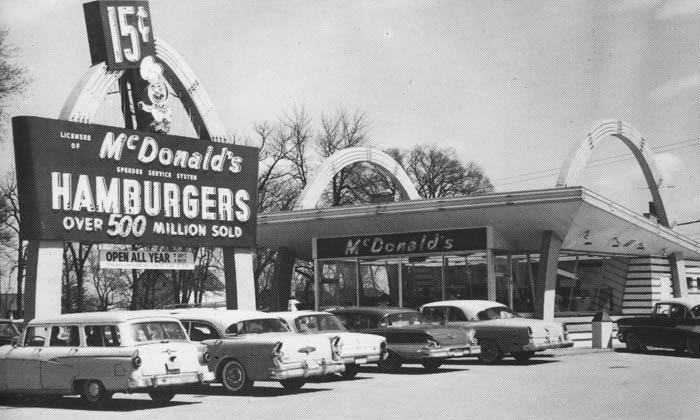Baby-boomers may recall, perhaps wistfully, how the golden-arched sign outside every McDonald's restaurant
婴儿潮出生的一代人也许还能够回忆起,可能会有些伤感,每家麦当劳餐厅外边的金拱门指示牌
would proclaim how many customers had been served by the chain.
是如何宣告它们服务了多少名顾客的。
As they became adults, the number kept on climbing: 5bn in 1969; 30bn in 1979; 80bn in 1990.
随着这代人步入成年,这个数字一直在攀升:1969年50亿人次;1979年300亿人次;1990年800亿人次。
Jerry Seinfeld, a wry chronicler of the trivial, was moved to ask: "Why is McDonald's still counting?"
滑稽的琐事编年史家杰瑞·宋飞感动地问:“为什么麦当劳还在统计着人数?”
Do we really need to know about every last burger? Just put up a sign that says, "We're doing very well."
我们真的需要知道每一个汉堡的一切么?只用立一个标牌说,“我们做的非常棒。“不就好了么。
The counting stopped. The signs said simply: "Billions and billions served".
统计停止了。标牌上简单地写着:“我们为数十亿顾客提供了服务。”
If this seems unhelpfully vague, that is how the counting business sometimes is.
如果这样显得模糊不清,那么统计行业有时就是如此。
Many of America's biggest companies, including McDonald's, report a negative book value, a gauge of a firm's net assets.
包括麦当劳在内的很多美国最大公司上报的账面价值都是负值,账面价值是对一家公司净资产的估量。
Many more have a book value that is small relative to their market value: their shares look dear on a price-to-book basis.
更多公司的账面价值和他们的市值相比相对较小:从股价与账面价值基础上来看,他们的股票很贵。
Much of this is down to the complexity of valuing a firm's assets in the digital age. But the result is that price-to-book is a bad guide to a stock's true value.
部分原因是由于,在这个数字时代,评估一家公司的资产很复杂。但结果就是股价与账面价值为股票真实价值提供了糟糕的指导。

一篮子无形资产(1).jpg
Stockpickers make a distinction between the price of a share and what it is truly worth.
选股高手分得清股票价格和它真实的价值。
Price is a creature of fickle sentiment, of greed and fear. Value, in contrast, depends on a firm's capabilities.
价格是变化无常的情绪的产物,或是贪婪或是恐惧。相反,价值取决于一家公司的能力。
There are various shorthand measures for this, but true "value" investors put the greatest store by the price-to-book ratio.
区分它们的速成方法各式各样,但是真正的“价值”投资者认为股价与账面价值比率是重中之重。
It is the basis for inclusion in benchmarks such as the Russell value index.
这是基准,如罗素价值指数,的包容基础。
Countless studies have shown that buying stocks with a low price-to-book is a winning strategy.
无数研究表明购买股价与账面价值比率低的股票是一种制胜策略。
But not recently. For much of the past decade, value stocks have lagged behind the general market and a long way behind "growth" stocks, their antithesis.
在过去将近十年时间里,价值股已经落后于共同市场,也远远落后于成长股—它们的对立股票。
Perhaps this is because, as the industrial age gives way to the digital age, the intangible assets that increasingly matter are not easy to put a value on.
这或许是因为,随着工业时代让步于数字时代,无形资产日益重要且其价值变得难以估量。
The tangible world is easier. Factories, machines, land and office buildings count as capital assets on a firm's books,
有形世界就容易得多。工厂、机器、土地和办公大楼都算作是公司的账面产,
because they will generate profits for many years. It is a fairly straightforward business to come up with a value for them:
因为它们将产生多年利润。为它们定价是一件相当简单的事情:
it is what the firm paid. This value is gradually written off (depreciated) over time to reflect wear and tear and obsolescence.
就是公司支付的价钱。这个价值随时间逐渐勾销(折旧),以体现它们的磨损和淘汰。
Such fixed capital assets, along with current assets (cash, stocks of unsold goods, and so on) typically make up the bulk of book value.
这种固定的资产以及流动资产(现金、未售出货物存货等等)组成了大部分的账面价值。
来源:经济学人

参与评论